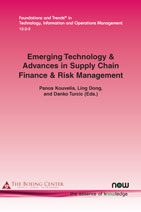Quadratic Hedging of Commodity and Energy Cash Flows
By Nicola Secomandi, Tepper School of Business, Carnegie Mellon University, USA, ns7@andrew.cmu.edu
Abstract
Commodity and energy prices are notoriously volatile. Firms routinely trade financial contracts to hedge their cash flows that are exposed to this source of risk. When markets are incomplete, which is typical in practice, eliminating such risk is impossible and attention must thus shift to its partial mitigation. This paper reviews quadratic hedging, which is an appealing financial risk management approach for this setting, considering a single commodity or energy cash flow that occurs on a given future date and assuming that financial hedging is based on trading a risk less bond and a futures contract. This work formulates this hedging problem as a Markov decision process, derives the optimal policy using stochastic dynamic programming, and characterizes the initial optimal bond position. Further, it highlights related current and potential future research.
Emerging Technology & Advances in Supply Chain Finance & Risk Management
Emerging Technology & Advances in Supply Chain Finance & Risk Management reflects the state-of-the-art in research thought leadership in supply chain finance and risk management, and it contains great expository pieces on how advanced technologies are shaping supply chains and risk management within them. You will also find ideas on how supply chain finance and risk management can be best taught in our classrooms.
The volume is divided into three parts, each part reflecting a major active research area of the field including: Part 1: Supply Chain Finance; Part 2: Financial Hedging and Commodity Risks; Part 3: Operational Strategies and Risk Management.
Part 1 deals with the broad area of supply chain finance and programs that will better allow for working capital management within supply chains. Part 2 introduces concepts of hedging financial and operational risks due to uncertain commodity prices, fluctuating exchange rates, and volatile interest rates. Emphasis is placed on understanding how financial hedges can be used for hedging relevant supply chain risks in a way that reflects modern view of financial risk management. Part 3 examines topics and solution approaches reflecting the more traditional treatments in the contemporary literature of operational and supply chain risks. This volume provides rich implications for future research directions in efforts to master the new complexities and uncertainties of the global business environment and better understand the impact of advanced technologies in global supply chains.

Companion
Foundations and Trends® in Technology, Information and Operations Management, Volume 12, Issue 2-3 Special Issue: Emerging Technology & Advances in Supply Chain Finance & Risk Management
See the other articles that are also part of this special issue.